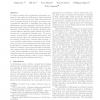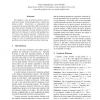WWW
2010
ACM
15 years 2 months ago
2010
ACM
We present two modifications to the popular k-means clustering algorithm to address the extreme requirements for latency, scalability, and sparsity encountered in user-facing web...
SDM
2009
SIAM
15 years 4 months ago
2009
SIAM
To obtain correlated and complementary information contained in text mining and bibliometrics, hybrid clustering to incorporate textual content and citation information has become...
ICML
2001
IEEE
15 years 7 months ago
2001
IEEE
Clustering is traditionally viewed as an unsupervised method for data analysis. However, in some cases information about the problem domain is available in addition to the data in...
ICPR
2008
IEEE
15 years 8 months ago
2008
IEEE
We introduce a class of geodesic distances and extend the K-means clustering algorithm to employ this distance metric. Empirically, we demonstrate that our geodesic K-means algori...
ICPR
2008
IEEE
15 years 8 months ago
2008
IEEE
We present a new L1-distance-based k-means clustering algorithm to address the challenge of clustering high-dimensional proportional vectors. The new algorithm explicitly incorpor...
CVPR
1997
IEEE
15 years 9 months ago
1997
IEEE
In this contribution we present an algorithm for tracking non-rigid, moving objects in a sequence of colored images, which were recorded by a non-stationary camera. The applicatio...


